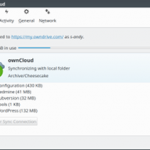In my book I explained, how to configure outgoing (also known as notifications) and incoming emails in Redmine and how to integrate this issue tracker with mail transport agents (this is about incoming emails). But, I completely missed the issues, which Redmine has with attachments for both types of emails. Eventually, I faced these issues in one of the projects, that I worked on.
2017
 ownCloud-based backup solution
(2 comments)
ownCloud-based backup solution
(2 comments)

Making everyday backups, while the data remain safe for years, may seem to be redundant and needless. Therefore, people realize, how stupid it was not to have backups, only when their data get lost (it happened to me too, quite a long time ago). However, backing up does not have to be a dull process. It can serve other purposes too…
In this article, I’m going to share the solution, that I personally use to back up this site. When looking for it, I wanted it to meet the following requirements:
 Personal report for 2017
Personal report for 2017
The personal report for the previous year can be seen here…
This is another report for one more failure year, but, I hope, for the last such one (as I’m doing very serious things to prevent this in future). In this year, I finally realized, that I got into a comfort zone (again), which did not allow me to move forward and which, eventually, appeared to be not really comfort. Now I understand, that this could be seen just by reading my previous reports (for 2015-2016), but I was too “blind” (that’s, actually, how the comfort zone works).
 Kayako API resource presentation
Kayako API resource presentation
There are two ways, in which you can design your API – you can create it for applications or you can create it for users. Historically, APIs were created for applications, what, I believe, was wrong. Your API is another your service, so it should be as friendly to the end user as possible, just like your normal services. And, it’s the user (e.g., a developer), that uses your API, not an application, that he/she is possibly writing (thus, some users can use your API through command-line CURL).
This is the approach, which is propagated by such famous API designers as Apigee and which was also taken by Kayako, when we were designing our API. And, that’s why we decided to use the current approach for the partial output, which we implemented with the help of the special fields= argument, that should be specified in the request URI.